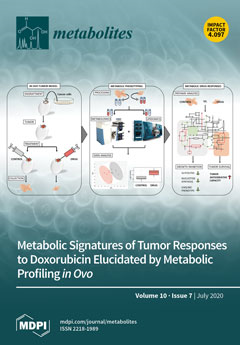Mitochondrial dysfunction after transient cerebral ischemia can be monitored by cerebral microdialysis (CMD) using changes in the lactate and pyruvate concentrations and ratio. Other metabolites associated with mitochondrial (dys)function are, e.g., tricyclic acid (TCA) and purine metabolites. Ethyl pyruvate (EP) is a putative neuroprotectant, supposedly targeting mitochondrial energy metabolism, but its effect on cerebral energy metabolism has never been described using microdialysis. In this study we monitored the metabolic effects of EP in the endothelin-1 (ET-1) rat model using perfusion with
13C-succinate and analysis of endogenous and
13C-labeled metabolites in the dialysates by liquid chromatography-mass spectrometry (LC-MS). Adult Sprague Dawley rats (
n = 27 of which
n = 11 were included in the study) were subjected to the microdialysis experiments. Microdialysis probes were perfused with
13C-labeled succinate (1 mM), and striatal dialysates were collected at 30 min intervals before induction of the insult, during intracerebral application of ET-1, and during intravenous treatment with either EP (40 mg/kg) or placebo, which was administered immediately after the insult. The rats were subjected to transient cerebral ischemia by unilateral microinjection of ET-1 in the piriform cortex, causing vasoconstriction of the medial cerebral artery. Monitoring was continued for 5 h after reperfusion, and levels of endogenous and
13C-labeled energy metabolites before and after ischemia-reperfusion were compared in EP-treated and control groups. Infarct volumes were assessed after 24 h. In both the EP-treated and placebo groups, ET-1-induced vasoconstriction resulted in a transient depression of interstitial glucose and elevation of lactate in the ipsilateral striatum. In the reperfusion phase, the concentrations of labeled malate, isocitrate, and lactate as well as endogenous xanthine were significantly higher in the EP-group than in the placebo-group: (mean ± SEM) labeled malate: 39.5% ± 14.9,
p = 0.008; labeled isocitrate: 134.8% ± 67.9,
p = 0.047; labeled lactate: 61% ± 22.0,
p = 0.007; and endogenous xanthine: 93.9% ± 28.3,
p = 0.0009. In the placebo group, significantly elevated levels of uridine were observed (mean ± SEM) 32.5% ± 12.7,
p = 0.01. Infarct volumes were not significantly different between EP-treated and placebo groups,
p = 0.4679. CMD labeled with
13C-succinate enabled detection of ischemic induction and EP treatment effects in the ET-1 rat model of transient focal cerebral ischemia. EP administered as a single intravenous bolus in the reperfusion-phase after transient cerebral ischemia increased de novo synthesis of several key intermediate energy metabolites (
13C-malate,
13C-isocitrate, and endogenous xanthine). In summary, mitochondria process
13C-succinate more effectively after EP treatment.
Full article






